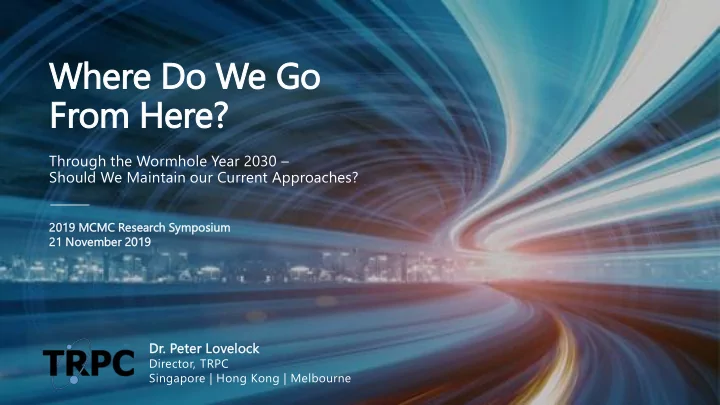

Where Do We Go From Here? Through the Wormhole Year 2030 – Should We Maintain our Current Approaches? 2019 MCMC Researc arch h Symposium um 21 Nove vember 2019 Dr. Peter Lovelock Director, TRPC Singapore | Hong Kong | Melbourne
Where are we heading? “Objectives drive behaviour” BUSINESS SOCIETY GOVERNMENT TECHNOLOGY • • • • Digital, real-time payments Hyper-connected digital Fully digital AI & ML • • • E-commerce dominance natives Smart cities, homes and VR & AR • • • Sharing economy Trans-humans military (… smart leaders ?) Cloud, Quantum computing • • • • Innovative Super-centenarians Automated Ubiquitous connectivity • • • products/services; Changing expectations Personalized Big Data • • Constant reinvention responsiveness DLTs • • • Privacy/digital Sustainability/ Competition and exposure Environmental Consumer POTENTIAL • Data breaches repercussions Protection CHALLENGES? • • • Cybersecurity Ethics/Safety Quality Control • attacks/incidents New actors
Where are we coming from? “Framing the future by learning from the past” Les esson #1 Those who meaningfully understand these KEY MIL KEY ILESTONES IN IN DI DIGITAL REV REVOLUTION technologies remain few. Governments should play a greater role in de develo loping un unders rstandin ing, and shaping 1969: Internet predecessor APRANET established 19 19 1984: First mobile phone introduced the direction and scope of growth/change. 19 1989: Tim Berners-Lee develops HTML, introduces the WWW 19 1992: Launch of commercial dial-up Internet; first audio and video distributed over the Internet 1993: Netscape launches 19 Les esson #2 19 1994: Sm Smart phones introduced Digital revolution has thus far ridden on a supply- 19 1995: Amazon, Craigslist and eBay go live, completing the driven development model — assuming demand Internet’s transformation to a commercial platform 19 1998: Google search engine born will naturally come. This has led to the digital 2000: Broadband introduced 20 exclusion of some in society. De Demand-driv iven 20 2002: Cloud technology begins with AWS launch init itia iatives need to be considered. 2004: Era of social media begins with Facebook 20 2005: YouTube launched 20 2007: The iPhone launched 20 Les esson #3 2011: Bitcoin becomes first widely accepted digital currency 20 20 2012: Google begins testing autonomous vehicles Technology should not be viewed as a tool to 2016: AlphaGo beats Go master 20 capture markets but an ena nabler of markets, 2019: 5G commercially deployed 20 innovation, and social development.
What t are we tr tryin ing to achie ieve? “Don’t become set by your goalposts—but be clear on the playing field” Access to Cyber-/ Digital Basic Digital National Ethics Literacy Services Security Sustainable Digital Development Fair Data Competition Reduce Digital Privacy Policy Protectionism Interoperable International Network Digital Standards Neutrality Safety Economies
What t do we need to get th there? “The rules of engagement” Engender multi-stakeholder , collaborative approaches towards market development and growth Develop new regulatory PRESENT FUTURE models within more holistic policy agenda setting Establish sandboxes , standards , and codes of conduct to guide innovation and development, and encourage interoperability
When/how should we ta take th the next steps? “Mapping the future” Globa bal/Regional C Challenges i in the Next W Wave o of Development Pers rsis istent di digit ital Budget 2020 is evidence of government’s strong • literacy gap commitment to digital transformation wit within in the the co country, but lacking focus on inter-economy opportunities. Government should collaborate more with regio ional/ • Alig ignment of f ASE SEAN counterparts to promote growth of regional regulatory regim imes digital economy, for e.g. on use of international standards — to increase interoperability, create access to more markets etc. Su Sustainabil ility Continue investment into edu ducation and development of • a relevantly skilled workforce — should see this as a long- term rm fou foundational com commit itment to support expected Buil Bu ilding tru trust exponential advancement of technologies and its digital economy.
Three Propositions The long-term trend will be towards valuation of the asset: Prop. 1 Data + what it enables New public-private models will emerge for joint development initiatives: Prop. 2 emerging around data access , sharing and use There will emerge a baseline set of digital economy and digital trade measurements: Prop. 3 based upon the use of data ( production of data, consumption of data) and trade in data
Recommend
More recommend